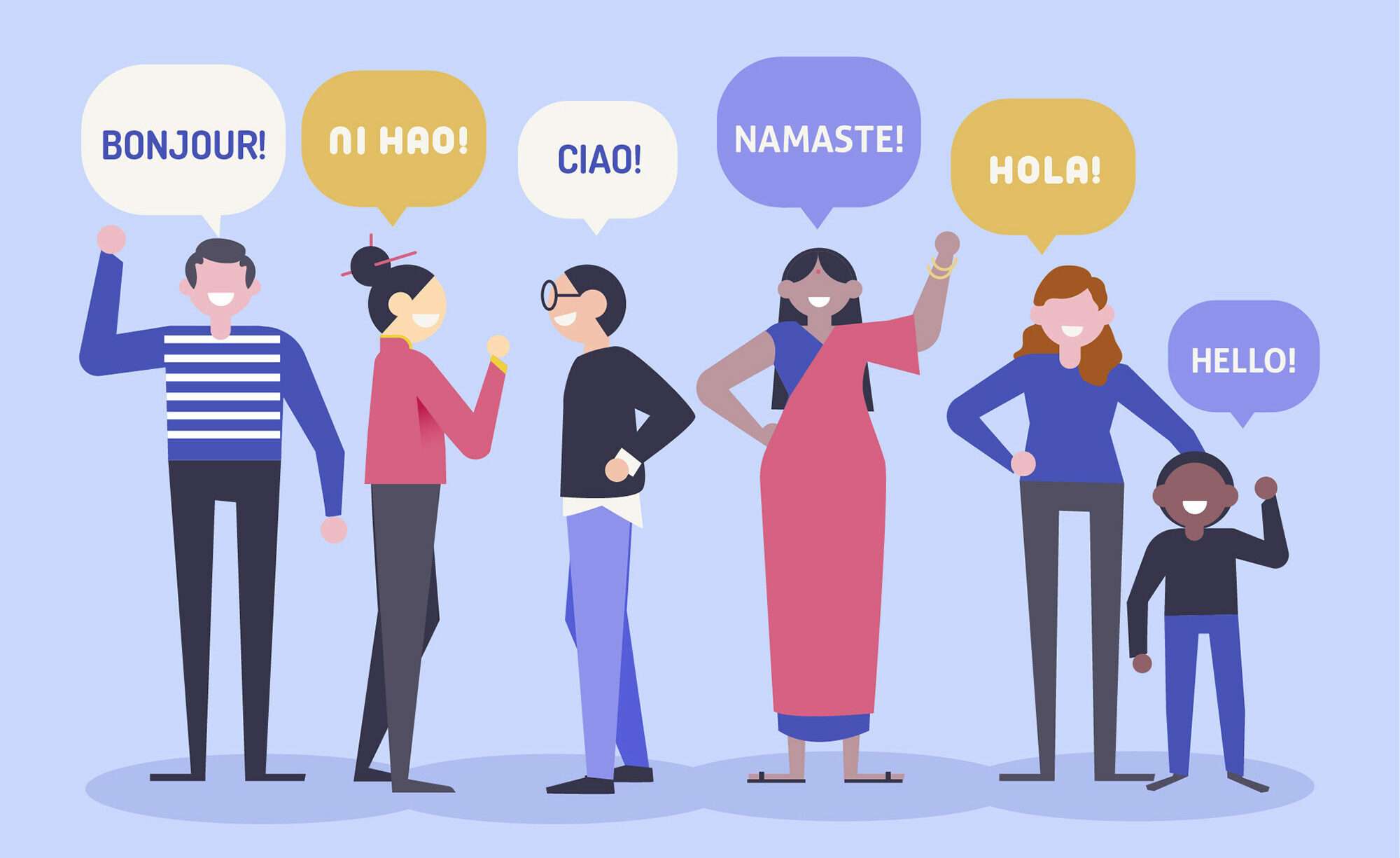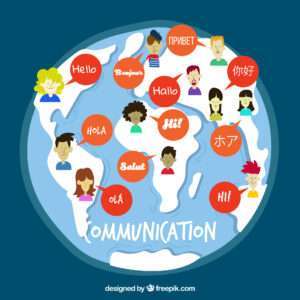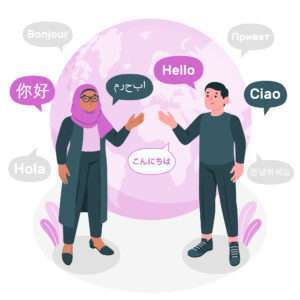

In a world that’s becoming more connected every day, cross-cultural communication has become increasingly important. When speaking with someone from another country or culture, it can be easy to misunderstand each other, even if you’re both speaking the same language. Language is a powerful tool that can help break down barriers between people of different cultures. It allows us to connect with each other on a deeper level and to better understand each other’s perspectives. In this blog post, we’ll explore the power of language in cross-cultural communication and how it can help us build stronger relationships with people from all over the world.
We’ll look at the challenges of cross-cultural communication, the benefits, and some tips for improving your cross-cultural communication skills. So, let’s dive in and discover how we can break down barriers and build bridges through language!
Language plays a critical role in cross-cultural communication. It is the key to unlocking the doors of understanding and building relationships with people from different cultural backgrounds. When we interact with people from different cultures, we come across a multitude of linguistic nuances, which can make communication challenging at times. However, it is essential to remember that language is not just a means of communication but also a reflection of a person’s culture, values, and beliefs.
Therefore, it is important to approach cross-cultural communication with an open mind and a willingness to learn and understand the nuances of different languages and cultures. Being able to communicate effectively in cross-cultural situations can help break down barriers, ultimately leading to stronger relationships. In this blog, we will explore the power of language in cross-cultural communication. Providing tips and insights on how to navigate language barriers to build stronger, more meaningful relationships with people from different cultures.

Language plays a crucial role in breaking down barriers in cross-cultural communication. It is the primary tool we use to communicate our thoughts, feelings, and ideas to others. Without a common language, it can be difficult, if not impossible, to understand and relate to people from different cultures.
Speaking another language can be a powerful way to show respect and interest in another culture. It can also help build trust and establish stronger relationships with people from different linguistic backgrounds. Even if you don’t speak their language fluently, making an effort to learn a few key phrases and greetings can go a long way in creating a positive impression.
Language can also be used to bridge cultural differences and find common ground. By learning about the linguistic nuances of another culture, you can gain a deeper understanding of their values, beliefs, and traditions. This can help you avoid misunderstandings and misinterpretations that can arise from differences in language or cultural norms.
In today’s globalized world, being able to communicate effectively across language and cultural barriers is more important than ever. By recognizing the power of language, you can become a more effective communicator and break down barriers to create deeper connections with people from all around the world.
Language plays a vital role in cross-cultural communication. It is a medium through which we express ourselves, share our thoughts, ideas, and feelings with others. Our language shapes our understanding of the world around us, and it influences our perception of other cultures.
When it comes to cross-cultural communication, language can create both barriers and opportunities. Language barriers can cause misunderstandings, misinterpretations, and miscommunications that can lead to conflicts or even business failures. On the other hand, language can be a powerful tool for building relationships and bridging cultural divides.
Learning the language of another culture shows respect for that culture and helps to create a more positive interaction. It also enables a deeper understanding of the culture and its customs, which can lead to better communication and more successful business relationships.
It’s important to remember that language is not just about words; it also includes non-verbal cues, such as tone, body language, and facial expressions. These non-verbal cues can differ from culture to culture, and it’s essential to be aware of them when communicating with people from different cultures.
In conclusion, language is a vital aspect of cross-cultural communication. It can either create barriers or opportunities, depending on how it’s used. By learning and respecting other languages and cultures, we can break down these barriers and create more meaningful and successful interactions.

Language is an essential tool for building relationships, especially in cross-cultural communication. When we speak the same language as someone else, it creates an immediate connection and helps to build trust. It’s not just about speaking the same words, but also understanding the nuances of the language and how it’s used in different cultures.
For example, in some cultures, direct communication is highly valued, while in others, speaking indirectly is the norm. Understanding these differences can help to build stronger relationships and avoid misunderstandings.
Speaking the language of your customer also shows that you value their culture and are willing to make an effort to communicate with them on their terms. This can go a long way in building trust and respect.
In addition, learning even basic phrases in another language can show that you are making an effort to connect with someone from a different culture. It can break down barriers and show that you are open to learning about their culture and way of life.
In short, language is a powerful tool in building relationships, especially when it comes to cross-cultural communication. It can help to break down barriers, build trust, and show that you value and respect other cultures.
One of the biggest challenges of learning a new language is the time and effort it takes to become proficient. Language acquisition is a complex process that requires a lot of practice and repetition. It can take years to become truly fluent in a foreign language, and even then, there may be certain nuances and colloquialisms that are difficult to grasp. Additionally, some languages have more complex grammar rules and sentence structures than others, making them even more challenging to learn.
Another challenge of learning a new language is the fear of making mistakes. Many people are self-conscious about their language skills and may be hesitant to speak up for fear of sounding foolish or making errors. This can be especially true in a professional setting, where the stakes may be higher and the pressure to perform can be intense.
Finally, there is the challenge of cultural differences that may be embedded in the language. Certain words or phrases may have different connotations or meanings in different cultures, and failing to understand these nuances can lead to misunderstandings or even offense. For example, in some cultures, direct communication is appreciated, while in others, indirect communication is favored. Understanding these cultural differences is important to effective cross-cultural communication.
Cross-cultural communication can be challenging, but it’s an essential aspect of doing business in a globalized world. Here are some tips for effective cross-cultural communication:
1. Be aware of cultural differences: Different cultures have different communication styles and norms. Understanding these differences can help you communicate more effectively with people from different cultural backgrounds.
2. Avoid assumptions: Avoid making assumptions about people based on their culture or background. Instead, ask questions to clarify any misunderstandings and to gain a better understanding of their perspective.
3. Listen actively: Active listening involves paying attention to what the other person is saying, asking questions, and seeking clarification when necessary. This can help you avoid misunderstandings and ensure that you’re on the same page.
4. Be mindful of your nonverbal communication: Nonverbal cues such as body language, facial expressions, and tone of voice can vary widely across cultures. Be mindful of these differences and adapt your nonverbal communication accordingly.
5. Use simple language: Avoid using complex vocabulary or jargon that may be difficult for non-native speakers to understand. Instead, use simple, clear language to ensure that your message is understood.
By following these tips, you can improve your cross-cultural communication skills and build stronger relationships with people from different cultural backgrounds.
Language is a reflection of culture and is influenced by various cultural factors. The first factor that impacts language use is cultural identity. A person’s cultural identity shapes the way they communicate and the language they use. For instance, in some cultures, it is considered rude to speak directly or look someone in the eyes while speaking. In other cultures, it is the norm to speak loudly and use hand gestures while communicating.
Another cultural factor that impacts language use is the level of formality. Cultures have different levels of formality in communication. For example, some cultures use formal language when addressing elders or those in positions of authority, while others use informal language even in professional settings.
The third factor that impacts language use is the context of communication. Each culture has its own set of rules and expectations for communication in different contexts. For example, in some cultures, it is acceptable to interrupt someone while they are speaking, while in others it is considered impolite.
Finally, cultural beliefs also impact language use. Different cultures have unique beliefs and values, which can be reflected in their language. For instance, in some cultures, certain words or expressions are considered taboo or offensive.
To effectively communicate across cultures, it is important to be aware of these cultural factors and adjust your language use accordingly. This not only ensures mutual understanding but also demonstrates respect for the other culture.
Communication is not just limited to language, and in cross-cultural interactions, nonverbal communication plays a significant role in conveying messages. However, nonverbal communication varies from culture to culture and it’s important to be aware of these differences to avoid misunderstandings.
Some nonverbal cues that may vary include facial expressions, gestures, posture, and eye contact. For example, in some cultures, direct eye contact is seen as a sign of respect and attentiveness, while in other cultures, it may be seen as confrontational or disrespectful.
It’s also important to be aware of body language and how it can differ between cultures. In some cultures, physical touch is common and may be seen as a way of expressing affection or friendship, while in other cultures, it may be seen as invasive or inappropriate.
It’s important to be mindful of these differences and adapt your communication style accordingly. Take the time to observe and learn about the cultural norms of the people you are interacting with. This will not only improve your communication but also demonstrate your respect for their culture.
In conclusion, understanding nonverbal communication in cross-cultural interactions is crucial for effective communication. It requires an open mind and a willingness to learn about cultural differences. By being aware of these differences, you can avoid misunderstandings and build stronger relationships with people from different cultures.
Technology has revolutionized the way we communicate, allowing us to connect with people from different parts of the world in real-time. This has made cross-cultural communication more accessible than ever before.
There are many tools available that can help bridge the language gap, such as translation apps, language learning software. These tools can facilitate communication between people who speak different languages and can help build relationships and understanding.
For example, platforms like Skype and Zoom have made it possible for people from different parts of the world to have face-to-face conversations without the need for travel. This has allowed for more frequent and meaningful interactions, which can help build trust and rapport.
Translation apps like Google Translate can also be a valuable tool, allowing for quick translation of text and speech in real-time. This can be especially helpful when communicating with people who speak a different language but are not proficient in English.
However, it’s important to be aware of the limitations of technology when it comes to cross-cultural communication. These tools are not perfect and can sometimes lead to misunderstandings or misinterpretations. It’s important to approach technology as a tool to aid communication, rather than a replacement for in-person interactions.
In conclusion, the power of language in cross-cultural communication cannot be overstated in today’s globalized world. As individuals, businesses, and societies become more interconnected, the need for effective communication across language barriers becomes increasingly important. Language is not just a tool for basic communication, but it also carries cultural nuances that can impact how messages are received and interpreted by different cultures.
By understanding the importance of language in cross-cultural communication, we can break down barriers. Investing in language learning and cultural awareness can lead to more successful collaborations in both personal and professional settings.
In a world where diversity and inclusion are becoming more important, we must strive to bridge the gap between cultures and promote communication that is respectful,. In doing so, we can harness the power of language to break down barriers and build a more connected and harmonious world.
We hope you found this article of languages unlimited on the power of language in cross-cultural communication to be insightful and informative. It’s important to remember that language is not only a tool for communication, but it is also a vital part of culture and identity. By breaking down the barriers created by language, we can better understand and connect with people from different cultures around the world. We hope this article motivates you to learn a new language and explore the diversity that exists in the world. Let’s break those language barriers and create a more united world!